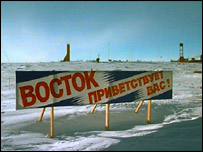American researchers redate the formation date of the Southern Passage between the Atlantic and Pacific Oceans, based on fossilized fish teeth
Antarctica began to freeze 41 million years ago
6.5.2006
From: Concentration of sources

The buried lakes of Antarctica are linked by networks of rivers that move water below the surface. British scientists say.
Until now, scientists believed that the lakes that are under the ice are sealed for millions of years and this allows unique creatures to exist in them. However, in an article in the journal Nature, experts write in light of the plans to dig into these lakes that it is now necessary to re-examine the matter. "Any attempt to dig into one of these bodies of water could contaminate the others."
Duncan Wingham, of University College London, says that "from what we see now, this could contaminate not just one body of water but its entire drainage system."
The transition between South America and Antarctica opened 41 million years ago
The southern passage between the Atlantic and Pacific Oceans opened 41 million years ago. This is according to a study conducted on fish teeth. Geologists in the USA believe that the opening of the passage caused the creation of sea currents around Antarctica and helped to create a significant cooling effect. This is how the continent turned from a forested and green surface into an ice dome.
"We now have an estimated date for the opening of the Drake Passage, which appears to be early enough to conclude that it contributed to the cooling process," said Dr. Ellen Eccles Martin of the University of Florida, "which illustrates the important role of ocean circulation in Earth's climate change."
Millions of years later, the Drake Passage – a stretch of sea between Antarctica and South America – still plays an important role in maintaining freezing temperatures in Antarctica. "We are warming the world with greenhouse gases, and this is leading to the disintegration of the ice sheet in West Antarctica. The cold current around the continent probably supports the slowing down of the process," said Martin.
The sea passage maintains the freeze on the ice continent
Drake Passage is named after Sir Francis Drake, the English navigator who circumnavigated the globe in the 16th century. According to the study, the transition was created when the continental "arm" that connected Antarctica to South America sank, millions of years ago.
The world was a completely different place then. Carbon dioxide levels were 3 or 4 times higher than today. The climate was so hot that crocodiles basked in the sun in the arctic region. 30 million years ago a dramatic change in climate occurred and the world began to cool significantly. The cooling led, in a process that lasted several million years, to replace the pine trees on the continent with glaciers.
Scientists have long believed that the Drake Passage played an important role in the cooling process, but until now the historical date was vague, with estimates ranging from 15 million to 49 million years ago. The team of researchers from the University of Florida extended the process based on a study of fish teeth, which were found on top of rocks - 300 meters below the bottom of the Atlantic Ocean.
A chemical called neodymium accumulated on the teeth. The researchers are able to differentiate between the chemical compositions of the Atlantic Ocean and those of the Pacific Ocean. This is how they determined when water penetrated from the Pacific Ocean into the Atlantic Ocean.
